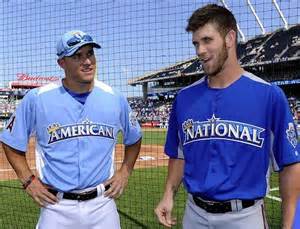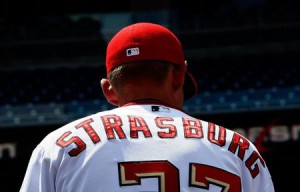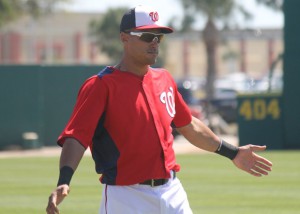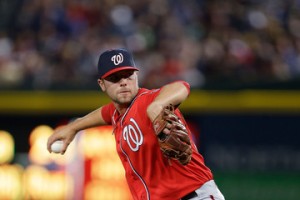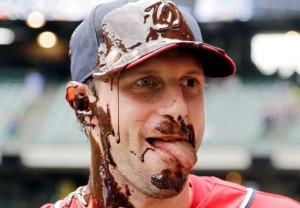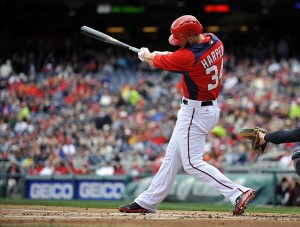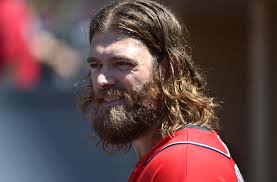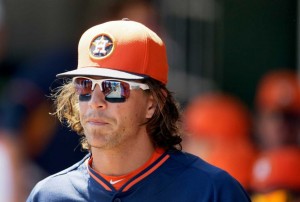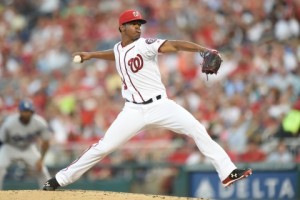
Lopez 2016 Nats minor league pitcher of the year; will it matter? Photo via wp.com/Mitchell Layton getty images
The Nats recently announced their 2016 Minor League Players of the Year, and then recognized them along with GCL MVP Juan Soto over the weekend.
Rafael Bautista, Reynaldo Lopez, Jose Marmolejos-Diaz and Juan Soto, who all hail from the Dominican Republic and represent the best evidence of the Nats long awaited “rebirth” in that market, were all recognized. And that’s great.
But how have the Nats Minor League Players of the Year fared in terms of eventual career accomplishment? Is this achievement a good precursor for MLB success? Lets dig deeper.
Here’s a list of the Nats declared prospects of the year (i’ve gone back beyond the Nats time in DC since prospects lag in terms of their arrival), along with some quick commentary on where they’ve gone:
- 2016: Jose Marmelejos-Diaz, Reynaldo Lopez: Lopez had some impact at the MLB level in his first shot, may factor into the post-season bullpen, but is looking at AAA next year unless an injury or trade occurs. Marmeloejos-Diaz is still too young to pass judgement. Verdict: too early to tell obviously; Is Lopez going to be an effective mid-rotation starter or (as some pundits believe) is he going to end up being more effective in the bullpen?
- 2015: Jose Marmelejos-Diaz, Austin Voth: Voth had a solid AAA season in 2016, but was (somewhat surprisingly) not called up on 9/1 despite facing Rule-5 protection this coming off-season. Has he peaked? Was he left off of the 40-man for strategic (i.e. trade bait) purposes? He’s clearly behind three other AAA guys on the depth chart right now with a full MLB roster; what does his future hold? Verdict: too early but concerns about Voth’s role going forward.
- 2014: Steven Souza, Lucas Giolito: Souza famously netted the team both Trea Turner and Joe Ross in trade, but has been an injury prone 1-win/year player for Tampa Bay ever since (total bWAR for Tampa: 1.9 in two seasons). Giolito’s jury is still out; despite his lofty prospect status he struggled on the big stage in 2016 amid reports of mechanical tweaks and struggles. Verdict: early on Giolito, Souza might be who he is.
- 2013: Billy Burns, Taylor Jordan: Burns netted the team Jerry Blevins in trade and then had one decent season with Oakland (a 2.8 bWAR season in 2015 that may have had the Nats with trader’s remorse. However, he struggled badly in 2016, was traded, was sent to the minors, and may not be much more than a defensive outfield bench player. Jordan had 9 promising starts in 2013, then struggled in spot starts in 2014, blew out his elbow, came back, struggled again in 2015 spot starts, blew out his elbow again this year and was summarily released. He may struggle to find a team willing to give a 4-A pitcher on his third elbow a shot going forward. Verdict: one may be done, one may be a 4th outfielder at best.
- 2012: Nathan Karns, Matt Skole: Karns was a lower-round draft pick with an injury history the Nats took a chance on and he shot through the system, taking just a season and a half to rise from low-A. The team capitalized on his promise and flipped him for three role players (Jose Lobaton, Felipe Rivero and Drew Vettleson). Since, Karns got flipped to Seattle, struggled early and has missed most of 2016 with a back strain. Skole is a polarizing figure amongst readers here; to me he is a 27yr old AAA power-only hitter who has had three consecutive NRI to spring training (so its not as if the MLB squad doesn’t know who he is). He’s at the end of his string with the Nats and likely moves elsewhere as a MLFA for next year. I wish he turned out better; after his fantastic 2012 season an unfortunate injury cost him all of 2013 and he really seems like he’s been playing catchup since. Verdict: Karns may turn out to be more than he’s shown, but Skole is a 6-year MLFA.
- 2011: Steve Lombardozzi, Brad Peacock: Lombardozzi made the majors as a 19th round pick (quite the rarity; it usually only happens 2-3 times per draft class), got traded in the Doug Fister deal, got traded again, then released, then picked up by Baltimore, then released again and found himself playing indy ball after getting cut by the Chicago White Sox this past spring. The Nats picked him up for their AAA team but he possesses a negative bWAR career value as a backup utility player. Peacock (not unlike Karns) had a brief debut with the Nats before getting used in trade to acquire others (in his case, going to Oakland as part of the Gio Gonzalez deal). Oakland flipped him to Houston, where he struggled as a starter in 2014 and has been basically a 4-A taxi squad member between their AAA team and their bullpen. Verdict: both guys ended up better AAA players than MLB players.
- 2010: Tyler Moore, Tommy Milone: Moore matriculated to the majors and had a fantastic 2012 off the bench (123 OPS+) … and then never matched it. The Nats traded him for Nate Freiman in a “moving the deck chairs” trade with Atlanta, and Moore spent most of 2016 off a 40-man and on the D/L. Milone, like Karns and Peacock after him, had a brief and exciting debut with the MLB club before being used as trade fodder for others (he was also in the Gonzalez trade). He excelled in Oakland’s big park and was then flipped for Sam Fuld to the Twins. He’s been less successful with Minnesota, getting dumped out of the rotation in 2016 and posting a 5+ ERA this year for baseball’s worst team. He may be a non-tender candidate and could be on the move again this winter. Verdict: At best a 4-A slugger and a 6th starter.
- 2009: Derek Norris, Brad Meyers: Is it interesting that three Nats Minor league players of the year were all included in the same trade? Norris was a centerpiece of the Gonzalez deal while still relatively a young minor leaguer; he peaked as an All Star in 2014 for Oakland before getting moved to San Diego in the Jesse Hahn deal. He’s struggled in San Diego, hitting just .186 this year. Meyers’ career is an injury plagued shame; after a fantastic 2009 he started 2010 just as well before getting hurt. He returned and had a solid 2011 in AA and AAA but was taken in Rule5 by the Yankees. He missed basically all of 2012 with injury and was returned as damaged goods, an injury that cost him all of 2013. By the time he made it back in 2014, he just had nothing left; after 6 starts in Harrisburg the team released him. Verdict: At least a backup catcher in the majors and an asterick due to injury.
- 2008: Leonard Davis, Jordan Zimmermann: Davis was named the hitter of the year on the back of a solid year at Potomac … when he was 24 and a year and a half older than the league. He kept climbing the ranks, hit .250 in Syracuse in 2011 but never got a shot in the majors. He bounced around indy ball for a copule of years but retired in 2013. Zimmermann is what we all know him to be: a 9-figure starter and easily the most successful player on this list .. which, not to bury the lede this early, is kind of the point of this article. Verdict: a AA washout and a #2 starter in the majors.
- 2007: Justin Maxwell, John Lannan: Maxwell toiled for years as a 4th OF for the Nats in their dark times before getting flipped for a middle reliever in Adam Olbrychowski. That started his itinerant career, playing for Houston, Kansas City, San Francisco and most recently Boston’s AAA team. He has now decamped for Korea. For his career he has a bWAR figure of 2.9, 2.4 of which came in his best season in Houston. Lannan famously went from Nats opening day starter and Ace during the “down years” to AAA insurance policy in 2012. After getting mercifully non-tendered in 2012, he played for two different NL East rivals in 2013-2014, and has pitched full AAA seasons in the PCL the last two years. 7.1 career bWAR, most of which was earned during his first two full seasons starting for the awful 2008 and 2009 Nats. Verdict: two MLB players, both of which had limited impact in their careers.
- 2006: Kory Casto, Zech Zinicola: Casto was a long-time Nats farmhand favorite, progressing slowly one level a year and always producing. He finally made the majors in 2007 but struggled in parts of two seasons and was outrighted off the 40-man after 2009. He elected FA, bounced around two organizations in 2010 before retiring in July of that year. Zincola won the Nats minor league pitcher of the year in a year when he threw just 32 innings as a closer, an indication of how bad our farm system was in the early years. He played for years in the Nats system, never making the majors, but interestingly played a full season this year with the independent Sugar Land Skeeters. Verdict: essentially two career minor leaguers.
- 2005: Kory Casto, Mike O’Conner: O’Conner became just the second pitcher in the history of George Washington baseball to make the majors (the first being a guy from the 1920s who had exactly one career IP). He gave the team 20 starts in 2006 and then had a grand total of 15 MLB innings thereafter, toiling for years in AAA. Verdict: as with Casto, essentially a career minor leaguer.
- 2004: Ryan Church: a late bloomer who won the Nats minor league player of the year the year he was acquired by destroying Edmonton before getting called up. By 2007 he was a solid contributor for the Nats and looked like a viable RF option for a few years. He got flipped to the Mets in Jim Bowden‘s ill-fated trade for the “toolsy” Lastings Milledge not uncoincidentally just before his first arbitration pay day, played there halfway decently for a year and a half before getting moved to Atlanta. He signed as a FA in Pittsburgh and struggled badly, and 2010 was his last year in the big leagues. Total career bWAR: 9.1, most of it in the three solid years he gave the Nats. Verdict: a MLB regular for a handful of seasons.
- 2003: Terrmel Sledge: Sledge won the Expos minor league award after an excellent year in AAA Edmonton. He was solid in 2004 for the big league club but then barely played in 2005 thanks to injury. That off-season he was flipped in the Alfonso Soriano deal, traded to San Diego a few weeks later, played two non-descript seasons there and then played 5 years in Japan, retiring after the 2012 season at the age of 35. Verdict: essentially a 4-A player.
Summary: 13 years of the franchise naming minor league players of the year (24 total guys) has produced:
- One legitimate MLB star (Zimmermann)
- 6 slightly better than replacement Major leaguers: Souza, Milone, Karns, Norris, Lannan, Church
- 9 basically 4-A players: Burns, Jordan, Lombardozzi, Peacock, Moore, Maxwell, Casto, O’Conner, Sledge
- 4 guys who never made the majors: Skole (as of yet), Meyers, Davis, Zinicola
- 4 guys who its too early to tell: Marmelejos-Diaz, Lopez, Voth, Giolito
Not a great track record. Lots of this is squarely on the shoulders of the early state of the farm system; fair enough. Its also wise to note that none of the main home-grown stars that the team as developed over the years appears on this list; No Zimmerman, Harper, Strasburg, Rendon, Storen, Cole, Solis, Ray, Espinosa, etc. That’s because these guys either raced through the minors or just never shined brightly enough at a particular level to earn the award.
Also interesting; look how many of these guys got flipped soon after their being named our POTY: Norris, Milone, Peacock, Karns, Burns, Souza. Its almost as if the team is trading high on more marginal prospects thanks to their POTY status. Look at the return in each of these deals; it seems like the Nats “won” the trade nearly every time.
Another interesting side note; while doing this I noticed that no less than four guys from the 2007 draft are on this list: Zimmermann (2nd), Souza (3rd), Norris (4th) and Meyers (5th). That draft also included future big leagers in Detwiler (1st), Smoker (1st-supp) and Smolinksi (2nd). and McCoy (10th). That’s a heck of a draft; all due credit.
